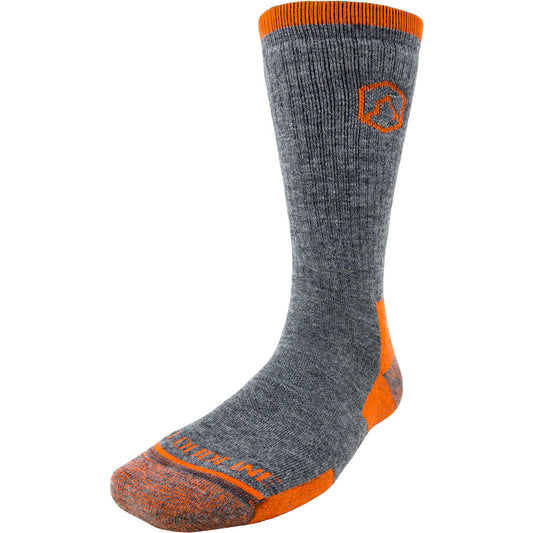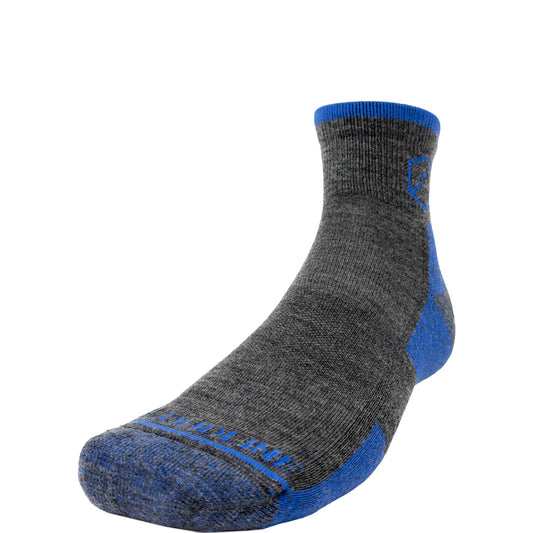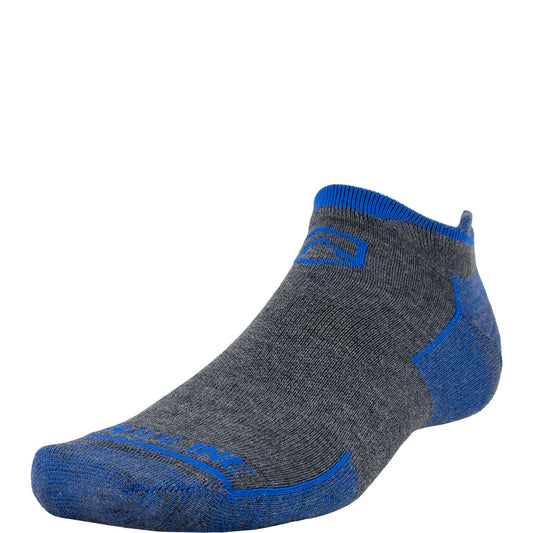
Why Thru-Hikers on the Pacific Crest Trail Swear by Merino Wool Socks
The Merino Advantage on the Pacific Crest Trail
If you've ever chatted with someone who's completed the grueling 2,650-mile journey from Mexico to Canada along the Pacific Crest Trail (PCT), you'll notice they develop strong opinions about gear. When your entire life fits in a backpack for five months, every item must earn its place. Among these trail-tested essentials, one piece of equipment consistently receives passionate endorsements: merino wool socks.
These aren't just casual recommendations—they're declarations from people who've tested their footwear through desert heat, mountain snow, river crossings, and everything in between. When thru-hikers evangelize about merino wool socks, they speak from experience measured in millions of footsteps.
The devotion to merino wool among PCT hikers isn't surprising when you understand the punishing demands of the trail. Your feet will carry you through extreme temperature fluctuations, across varied terrain, and through unpredictable weather. The average thru-hiker takes approximately 5 million steps to complete the journey—that's 5 million opportunities for blisters, hot spots, and foot fatigue if you're wearing the wrong socks.
Why PCT Hikers Face Unique Sock Challenges
The PCT presents distinctive challenges that put extraordinary demands on footwear. A typical day might begin with a frigid mountain morning, transition to scorching midday heat, include a refreshing (but sock-soaking) stream crossing, and end with another temperature drop at higher elevation. All while carrying a pack and covering 20+ miles.
This dynamic environment creates the perfect testing ground for sock performance. Those who've completed the trail have essentially conducted a months-long product trial in the most demanding conditions imaginable. When these veterans overwhelmingly favor merino wool, their experience deserves attention.
"I started the PCT with synthetic socks because I thought they'd dry faster. Three hundred miles and seven blisters later, I switched to merino and hiked the remaining 2,350 miles with happy feet. Never going back." - Marcus K., 2019 PCT Thru-Hiker
The Science Behind Merino's Superior Performance
Merino wool isn't just another fabric—it's a natural engineering marvel perfectly suited for the demands of long-distance hiking. The secret lies in the microscopic structure of merino wool fibers, which differ significantly from both synthetic materials and traditional wool.
Each merino fiber features microscopic scales that create tiny air pockets, providing natural insulation while allowing moisture vapor to escape. This structure explains why merino wool offers such remarkable performance characteristics that Pacific Crest Trail hikers have come to depend on.
Natural Temperature Regulation
Perhaps merino's most appreciated quality among PCT hikers is its thermoregulation capability. The fiber structure actively responds to body temperature changes—insulating when cold and cooling when hot. This adaptability proves invaluable on a trail where you might encounter freezing mornings in the Sierra Nevada and blistering afternoons in the Mojave Desert within the same week.
The crimped structure of merino fibers creates millions of tiny air pockets that trap body heat when temperatures drop. Conversely, when temperatures rise, these same fibers wick moisture away from the skin, creating a natural cooling effect as the moisture evaporates. This dynamic response to changing conditions is something synthetic materials simply cannot replicate with the same effectiveness.
Moisture Management Excellence
Merino wool can absorb up to 30% of its weight in moisture while still feeling dry against the skin. This hygroscopic property allows merino socks to pull sweat away from your feet before you even notice dampness. For PCT hikers, who might put in 12-hour days of continuous movement, this moisture management prevents the maceration that leads to blisters.
Even more impressively, merino wool can absorb moisture in vapor form before it becomes liquid sweat. This proactive moisture management keeps feet drier from the start, rather than simply drying them after they've become wet.
The Anti-Blister Properties That Save PCT Hikes
Nothing derails a thru-hike faster than foot problems. When PCT hikers praise merino wool socks, they're often acknowledging how these socks have literally saved their journey. The connection between merino wool and blister prevention is well-established among the long-distance hiking community.
Friction and moisture create the perfect environment for blisters to form. Merino wool combats both these factors through several mechanisms. The natural elasticity of the fibers creates a snug fit that reduces slippage inside the shoe, while the superior moisture management keeps skin dry and less prone to friction damage.
Friction Reduction Through Superior Fit
Merino wool fibers have natural elasticity that helps socks maintain their shape even after days of continuous wear. This consistent fit ensures the sock moves with your foot rather than against it. The Pacific Crest Trail's varied terrain means your feet are constantly adjusting to different slopes, surfaces, and stride patterns—having socks that move harmoniously with these adjustments significantly reduces friction.
Additionally, premium merino wool socks like those from Cloudline feature strategic cushioning and anatomical design that further reduce friction points. These thoughtful design elements, combined with merino's natural properties, create an anti-blister system that PCT hikers have come to trust implicitly.
Antimicrobial Properties for Extended Wear
The antimicrobial properties of merino wool play an underappreciated role in blister prevention. The lanolin naturally present in merino inhibits bacterial growth, reducing odor and the skin breakdown that can precede blister formation. This becomes especially important for thru-hikers who may need to wear the same socks for multiple days between town stops.
Many PCT hikers report being able to wear their merino wool socks for significantly longer periods between washes compared to synthetic alternatives, without experiencing the skin irritation or degradation that can lead to blisters. This extended wear capability directly translates to carrying fewer pairs, lightening pack weight—a crucial consideration for those hiking thousands of miles.
Durability That Matches the PCT's Demands
The Pacific Crest Trail is notoriously hard on gear. Anything that survives the entire trail has proven its durability in the most demanding conditions. Quality merino wool socks consistently earn their reputation for longevity among thru-hikers who put their gear through extreme tests.
Modern merino wool socks designed for hiking incorporate reinforcement in high-wear areas like heels and toes. These targeted durability features, combined with merino's natural resilience, create socks that can withstand the punishment of a 2,650-mile journey.
Longevity Despite Constant Use
PCT hikers typically rotate between 2-3 pairs of socks for the entire trail. This intense usage would destroy inferior socks within weeks, but quality merino wool options consistently perform for thousands of miles. The natural elasticity of merino fibers allows them to recover their shape after compression, preventing the premature breakdown that occurs with many synthetic alternatives.
Premium merino wool socks often incorporate nylon reinforcement in strategic areas while maintaining merino's dominance in foot-contact areas. This hybrid approach maximizes both comfort and durability—a balance that Pacific Crest Trail hikers particularly appreciate as they depend on minimal gear for maximum performance.
| Sock Material | Average Lifespan on PCT | Common Failure Points |
|---|---|---|
| Budget Cotton | 50-100 miles | Blistering, loss of cushioning, holes |
| Synthetic Hiking Socks | 300-500 miles | Cushion compression, elastic failure |
| Quality Merino Wool | 800-1000+ miles | Gradual thinning at heel/toe |
Practical Advantages for Long-Distance Hikers
Beyond the technical performance benefits, merino wool socks offer practical advantages that make them particularly well-suited to the logistics and realities of long-distance hiking on the Pacific Crest Trail.
Thru-hikers must constantly balance performance against weight, packability, and versatility. Every item carried must serve multiple purposes and perform reliably with minimal maintenance. Merino wool socks excel in this context, offering practical benefits that extend beyond their wearing comfort.
Odor Resistance for Trail Life
The antimicrobial properties of merino wool translate to remarkable odor resistance—a benefit that becomes increasingly appreciated as days between town stops accumulate. While synthetic socks quickly develop persistent odors that can survive washing, merino wool naturally inhibits the bacteria that cause odor.
This practical advantage means PCT hikers can maintain better hygiene with fewer pairs of socks, reducing both pack weight and the frequency of sock washing. When reaching town after a week on trail, being able to wear relatively odor-free socks into a restaurant or hostel represents a small but meaningful quality-of-life improvement that experienced hikers value.
Fast-Drying Performance in Variable Conditions
Contrary to popular misconception, quality merino wool socks dry remarkably quickly after becoming wet. While they may not dry as rapidly as the thinnest synthetic options, their ability to remain comfortable while damp gives them a practical advantage on the PCT, where stream crossings and unexpected weather are inevitable.
Many hikers report that merino wool socks feel comfortable and functional even when not completely dry—a stark contrast to the clammy discomfort of damp synthetic materials. This property allows hikers to continue moving comfortably after water crossings rather than needing to stop and fully dry their footwear.
How to Select the Right Merino Socks for Your PCT Journey
Not all merino wool socks are created equal, and selecting the right pair can significantly impact your Pacific Crest Trail experience. Veteran thru-hikers typically recommend considering several key factors when choosing merino socks for long-distance hiking.
The ideal merino sock strikes a balance between cushioning, durability, and moisture management. Finding this balance requires understanding how different design elements and merino blends perform in the specific conditions you'll encounter on the PCT.
Merino Content and Blend Considerations
The percentage of merino wool in a sock directly affects its performance characteristics. Higher merino content generally provides better temperature regulation and odor resistance, while blends with synthetic fibers like nylon and spandex enhance durability and fit retention.
For the Pacific Crest Trail, most experienced hikers recommend socks with at least 50-70% merino content, with the remainder comprising durable synthetic fibers. This blend maximizes merino's natural benefits while enhancing longevity for the demands of thru-hiking.
- 70%+ merino content: Maximum comfort and temperature regulation, slightly less durable
- 50-70% merino content: Excellent balance of comfort and durability for long-distance hiking
- 30-50% merino content: Greater durability but fewer of merino's natural benefits
Cushioning and Thickness Selection
Cushioning preferences vary among PCT hikers, with considerations including shoe fit, hiking style, and seasonal timing. Many successful thru-hikers use different cushioning levels for different trail sections.
Lightweight cushioning and Ultralight (no cushion) excels in the hot desert sections where heat dissipation is critical, while medium cushioning offers versatility across most trail conditions. Heavy cushioning provides extra protection in rough terrain and colder conditions but can increase sweating in hot weather.
Many experienced PCT hikers recommend starting with medium-cushion merino socks and adjusting based on personal experience. The adaptive temperature regulation of merino wool helps make medium cushioning viable across a wider range of conditions than would be possible with synthetic materials.
Maintaining Merino Socks on a Thru-Hike
Proper care extends the life of merino wool socks—crucial knowledge for PCT hikers who depend on their footwear for thousands of miles. While merino is naturally resilient, thru-hikers have developed specific maintenance practices that maximize performance throughout their journey.
The good news is that merino wool requires less frequent washing than synthetic alternatives, and when washing is necessary, the process can be adapted to the limitations of trail life. Proper maintenance not only extends sock lifespan but also preserves the performance characteristics that make merino ideal for long-distance hiking.
Trail Washing Techniques
When traditional laundry facilities aren't available, PCT hikers employ creative methods to keep their merino socks functional. The natural antimicrobial properties of merino wool make it possible to go longer between washes without compromising hygiene, but periodic cleaning still improves comfort and performance.
A common trail washing technique involves rinsing socks in a stream or lake, gently agitating them to remove dirt and salt buildup, then pressing (not wringing) them to remove excess water. Many hikers will then "pre-dry" their socks by wrapping them in a bandana or camp towel and stepping on them to extract additional moisture before hanging them to dry.
Extending Sock Lifespan During Your Thru-Hike
Beyond washing, several practices can significantly extend the life of merino wool socks on the PCT. Regular rotation between pairs allows each sock to fully dry and recover elasticity. Immediately removing socks when making camp helps them dry overnight and prevents unnecessary wear during rest periods.
Preventative maintenance also plays a key role in sock longevity. Many experienced hikers routinely inspect their socks for early signs of thinning and address hot spots before they develop into holes. Some carry small repair kits specifically for sock maintenance, finding that minor repairs can significantly extend usable lifespan.
Frequently Asked Questions About Merino Wool Socks for PCT Hikers
How many pairs of merino socks should I carry on the PCT?
Most successful PCT thru-hikers carry 2-3 pairs of merino wool socks. This rotation allows one pair to be worn while the others dry after washing or from perspiration/water crossings. The odor-resistant properties of merino make this minimal rotation practical, while the quick-drying capability ensures you'll rarely be without a functional pair. Carrying more than three pairs generally represents unnecessary pack weight that experienced hikers avoid.
Are merino wool socks worth the higher price for thru-hiking?
PCT veterans overwhelmingly confirm that quality merino wool socks represent one of the best value investments in hiking gear, despite their higher initial cost. When calculated on a per-mile basis, premium merino socks often cost less than budget alternatives due to their superior durability. More importantly, the blister prevention and comfort benefits can be the difference between a successful thru-hike and one cut short by foot problems. Few gear investments deliver more direct impact on hiking success and comfort.
Do I need different merino sock weights for different PCT sections?
While some hikers successfully use the same sock weight throughout the trail, many experienced PCT hikers optimize their sock selection for different sections. Lighter-weight merino socks excel in the Southern California desert sections, while medium-weight options provide versatility through Northern California and Oregon. Some hikers prefer slightly heavier cushioning for the Washington section, especially if hiking later in the season when temperatures drop. The natural temperature regulation of merino makes this adaptation less critical than it would be with synthetic materials.
Ultimately, successful PCT hikers don't just wear merino wool socks—they depend on them. When your feet carry you 2,650 miles through ever-changing conditions, the consistent performance of merino wool becomes not just a preference but an essential component of thru-hiking success.




